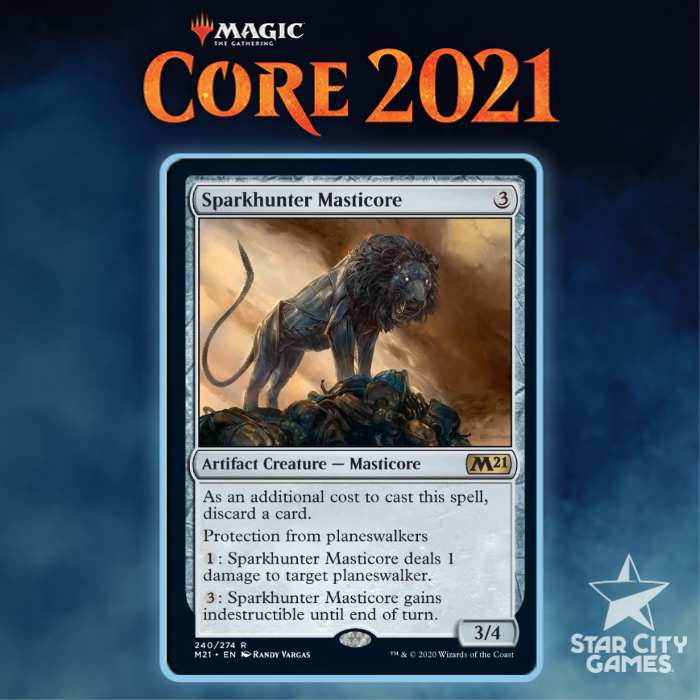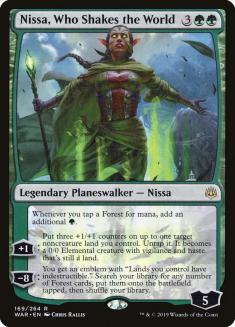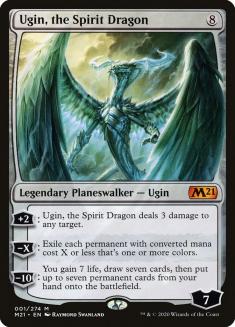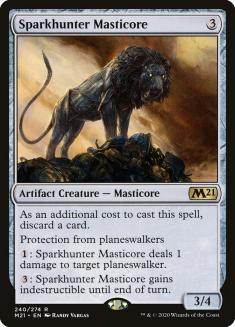Sparkhunter Masticore is a unique breed of “hate card” soon to be released in Core Set 2021.
We’ve seen our share of reprints and cards with familiar effects previewed already, but Sparkhunter Masticore has almost no analogous cards in existence. We’re going to talk today about what its realistic level of impact is by examining the shape of Standard and how Sparkhunter Masticore can fit into this environment.
First, its abilities:
As an additional cost to cast this spell, discard a card.
Getting the worst out of the way — the drawback (and also the callback to original Masticore and all of its variants over the years). Being down a whole card to make a play is typically a huge weakness. A card with this level of drawback needs a sizable amount of rate with the ability to make a significant impact on battlefields and the game to justify playing this type of card in your deck. As we’ll soon get to, thankfully Sparkhunter Masticore is quite strong against a card type that’s very good at generating card advantage.
The dream is to either mitigate this drawback or turn it into upside. The former can be achieved by pairing Sparkhunter Masticore with Theros Beyond Death Titans or other escape cards. The latter is something more akin to a Reanimator strategy. While decks like Reanimator are incredibly fringe, there are many Rakdos variants that could use a strong creature to pair with Kroxa, Titan of Death’s Hunger.
While not the best comparison in terms of card structure — Rotting Regisaur is, in some respects, a justification that cards with downsides can still exist in Standard (although Sparkhunter Masticore is far weaker to countermagic). While with Regisaur, you’re netting an incredible amount of stats on investment, Sparkhunter Masticore is a bit different.
Protection from planeswalkers
This is a unique line of text. It’s been encompassed before in cards like Progenitus with its “protection from everything” but we’ve never seen something so uniquely equipped to brawl with planeswalkers. Planeswalkers like Teferi, Time Raveler that use an ability as a means to protect themselves are significantly weaker to Sparkhunter Masticore than those that utilize tokens or other means of impacting the battlefield externally. As a colorless creature, Sparkhunter Masticore is also completely immune to Ugin, the Spirit Dragon’s abilities that are typically so potent at cleaning up battlefields of permanents.
1: Sparkhunter Masticore deals 1 damage to target planeswalker.
The key line of text. While protection from planeswalkers is… undoubtedly strong against planeswalkers, it still has the implication of needing to untap with a creature and successfully attack the ‘walker, which as I previously mentioned can still be naturally impeded by tokens or any of the other Magic your opponent is playing. Even if attacked down over a couple of turn cycles, planeswalkers can still frequently generate enough advantage to snowball the game. Sparkhunter Masticore’s unique ability to “shoot down” a planeswalker sharply curbs their ability to generate any traction. Further, this ability is particularly strong against unique battlefields of multiple War of the Spark planeswalkers as they are typically hanging around with just a few loyalty left — ready to be picked off.
Even in the case of high-loyalty planeswalkers, Sparkhunter can prove highly effective due to its ability to let you maximize your mana as efficiently as possible and even break up killing a planeswalker over a turn cycle. As we’ll get back to shortly, this unique strength of “preemptively checking” a planeswalker is one of Sparkhunter Masticore’s greatest and most distinctive assets as a hate card.
3: Sparkhunter Masticore gains indestructible until end of turn.
Some type of resilience is another Masticore staple, and while not at the most generous rate, three mana is still manageable enough when you anticipate a sweeper from your opponent or improving your ability to get into combat. This is also an excellent ability to mutate onto, or to invest heavily in with Auras like All That Glitters.
3/4
This stat line is important for a variety of reasons. Sparkhunter Masticore’s power plus your available mana essentially dictates what amount of loyalty you can dismantle on a given turn, and six or more is enough to check Nissa, Who Shakes the World as well as all the other commonly played planeswalkers on curve.
While a 3/4 for three mana isn’t exactly a deal (especially considering the drawback), it’s still hovering at an acceptable rate, and when paired with indestructibility, Sparkhunter Masticore is a relevant individual threat.
Four toughness is key, as it dodges Scorching Dragonfire and Deafening Clarion, and in terms of its primary job, it lets you threaten Nissa without getting stonewalled by her animated lands. In an alternate timeline, Sparkhunter Masticore would have even torn through a herd of Elks.
What the Masticore does have an extreme weakness to is Eliminate and Brazen Borrower. While it’s to be seen how much of an impact Eliminate will have, Brazen Borrower is certainly a metagame staple and has the potential to pose a large threat to the Masticore’s viability in certain slices of the metagame. Mitigating this will be tricky, and will likely involve either your own countermagic or fitting into a Gods Willing strategy alongside All That Glitters and other artifact synergies.
So, Where Should I Put This Card and What Should I Expect?
Outside of some fringe discard synergies, nothing about Sparkhunter Masticore is a build-around or even really a generic rate card. It doesn’t exactly inspire new decks or act as a centerpoint of a strategy, and this can make it difficult to contextualize and visualize a place for during preview season.
As I alluded to previously, the most powerful play pattern at Sparkhunter Masticore’s disposal is to preemptively “check” opposing planeswalkers. The most common situation in Standard will be against Teferi, Time Raveler — while most creatures can be cleanly answered by Teferi’s -3, the Masticore isn’t having any of it. Sparkhunter Masticore is one of the absolute best proactive plays into the face of a potential Teferi.
Not allowing the planeswalker to collapse your battlefield position is critically important, and just one turn of reprieve can make a huge difference. Being able to leverage a foothold in the game is likely the best avenue for maximizing Sparkhunter, and as a result you typically want to pair it with other high-impact threats. Haste creatures like Questing Beast or Gruul Spellbreaker are excellent candidates, and I could even see the Masticore even being a part of a Winota strategy (RIP in Historic as of about five minutes ago as I drafted this sentence).
This one-two punch is getting a lot of attention, and for good reason. Nissa is problematic to defeat when it gets to untap and fuel Hydroid Krasis or just turbo-charge a deck like Yorion Bant Control, but there aren’t going to be many scenarios where the game is in doubt when she curves into Ugin on Turn 4 or 5.
Sparkhunter Masticore has the potential to keep this combination in check by never allowing your opponent to untap with Nissa. In long contests it can singlehandedly survive and answer Ugin. In some cases, you may just need to attack a couple of times to get over the finish line, and Ugin simply isn’t an answer to the Masticore.
Sparkhunter looks particularly well-suited for a Flash game early in the format when a lot of the spotlight will be on Nissa and Ugin. Leaving up mana to shoot Nissa or be able to play countermagic and/or develop your battlefield while never creating a shields down moment is a big deal against an extremely explosive tap-out strategy.
Generally, I see Sparkhunter slotting into green and Rakdos-centric decks primarily. It won’t make a great curve-topper and typically swarming aggressive decks are naturally strong against planeswalkers (or they aren’t what’s actually making the biggest impact on the game — a sweeper or something similar is). As a litmus test, any deck that primarily had weak options in their three-drop slot against Teferi, Time Raveler is a good place to think about slotting the Masticore.
What About as a Sideboard Card?
Sparkhunter Masticore feels stronger as a maindeck card — something that your curve is built for and in a strategy where you have sufficient ways to supplement the pressure it can generate. This is a singular stance for a card that’s so heavily slated towards punishing a card type.
That said, as a sideboard card, Sparkhunter Masticore might be best for its sizing and resiliency, with the planeswalker text being more of a bonus.
For example, in a Simic deck that doesn’t have a lot of options for sturdy blockers on Turn 3, Masticore could fill a hole in your deck’s curve to get in front of aggressive red creatures.
Perhaps if you’re sideboarding into more of an aggressive strategy with Nightpack Ambusher or Questing Beast, then the Masticore could help create a cohesive package that lets you get onto the battlefield.
Decks like Dimir Flash, Arclight Phoenix, and others that are typically extremely weak to Teferi, Time Raveler or Narset, Parter of Veils could also look into the Masticore to help breathe new life into their strategies.
Undoubtedly, the fact that Sparkhunter Masticore is colorless will be its biggest draw — and I expect to see it showing up in small numbers in a variety of decks.
It’s difficult to predict now what lasting impact Sparkhunter Masticore will have on Standard, but it’s hard to imagine it doing anything but help the “heroes” against some of the planeswalkers that have been format staples for some time now.






